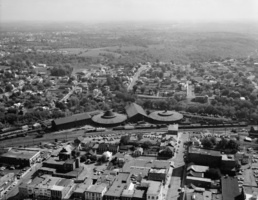
Martinsburg, the county seat of Berkeley County, was laid out in 1773 by Gen. Adam Stephen. The tract of land along Tuscarora Creek had been settled in the 1740s by Joseph Morgan and his brother, John Morgan, from Pennsylvania. Stephen established gristmills and flaxseed-oil mills along the banks of Tuscarora Creek. Stephen built his house of native limestone on lot 104. The house has been restored by the General Adam Stephen Association.
Berkeley County was established in 1772, and Stephen succeeded in getting Martinsburg declared the county seat over Jacob Hite’s proposed Hitetown (now Leetown). Stephen named the town for Colonel Thomas Bryan Martin, a nephew of Lord Fairfax. The county jail, once joining the courthouse, was completed in 1774, but the courthouse was not completed until 1779. Martinsburg was incorporated by the General Assembly of Virginia on October 18, 1778.
The Baltimore & Ohio (B&O) Railroad came to Martinsburg in 1842, and a roundhouse and machine shops were established. Many of the early railroad workers were Irish, and soon the area east of Tuscarora Creek was called Irish Hill. With the railroad’s arrival, the city grew dramatically. By the time of the Civil War, Martinsburg was the second largest city in the Shenandoah Valley, with a population of 3,364. During the war, the B&O suffered great loss, particularly in Martinsburg, where all the buildings belonging to the railroad were destroyed. Martinsburg was quick to recover after the war, with a new roundhouse being completed in 1866. The great railroad strike of 1877, the first nationwide industrial strike, originated among B&O workers at Martinsburg.
Henry Hannis purchased the old Nadenbousch distillery in 1867 and rebuilt it into a nationally known distillery. A city waterworks was established in 1873, and natural gas was put in many of the downtown buildings by 1873.
A second railroad, the Martinsburg & Potomac, came to the city from the Williamsport, Maryland, area in 1873. By 1888, this railroad was extended to neighboring Frederick County, Virginia. By the time of the city centennial in 1878, Martinsburg was booming. Several three-story buildings had been built in the main downtown section. The B&O had restored and added to the old 1849 National Hotel, which had become the train station after the Civil War. The new Berkeley Hotel opened in 1876. In 1890, electricity came to Martinsburg.
Martinsburg had a thriving textile industry dating back to the early 1800s, but it flourished on a much larger scale from the 1890s to 1970s. The Middlesex Knitting Company was established in 1890. The Martinsburg Mining, Manufacturing, and Improvement Company bought several hundred acres on the south side of Martinsburg, laid out lots, and recruited textile firms. Within a few years the Shenandoah Pants Company, the Crawford Woolen Company, the Interwoven Mills, and Southern Merchant Tailoring Company opened plants.
By 1940, Martinsburg had four movie houses and was the main business section of Berkeley County. After World War II, change came to the city. Shopping malls developed. Americans ceased to travel by train, and the railroad shifted from steam power to diesel. By 1990, the B&O shop had closed.
A north-to-south section of I-81 was built across the county through Martinsburg in the latter half of the 1900s. The interstate’s arrival and Amtrak’s commuter rail service would help transform Martinsburg’s economy and generate an influx of new residents, many of whom live in the city and commute to the Baltimore-Washington metro area and other locations in Maryland and Virginia. During the early 21st century, Martinsburg would become one of the state’s fastest growing cities. In 2020, Martinsburg’s population was 18,773, a 25.4 percent increase from 2000, making it West Virginia’s seventh most populous city, trailing only Charleston, Huntington, Parkersburg, Morgantown, Wheeling, and Weirton.
In the late 20th and early 21st centuries, much was done to help preserve many of Martinsburg’s historic buildings. Sixteen historic districts are listed in the National Register of Historic Places. In December 1980, the home of Belle Boyd, the colorful Confederate spy, became a museum and archive center. A portion of the restored B&O roundhouse and shop buildings, a National Historic Landmark, hosts public and private events. The 1890 Old Federal Building in the Richardsonian Romanesque architecture style is now home to the Federal Aviation Administration Records Center. The 1912 Apollo Theatre, which also has been restored, is a popular venue for live entertainment and other events.
This Article was written by Don C. Wood
Last Revised on February 22, 2023
Cite This Article
Wood, Don C. "Martinsburg." e-WV: The West Virginia Encyclopedia. 22 February 2023. Web. 26 July 2024.


Comments?
There aren't any comments for this article yet.
Click here to read and contribute to the discussion →